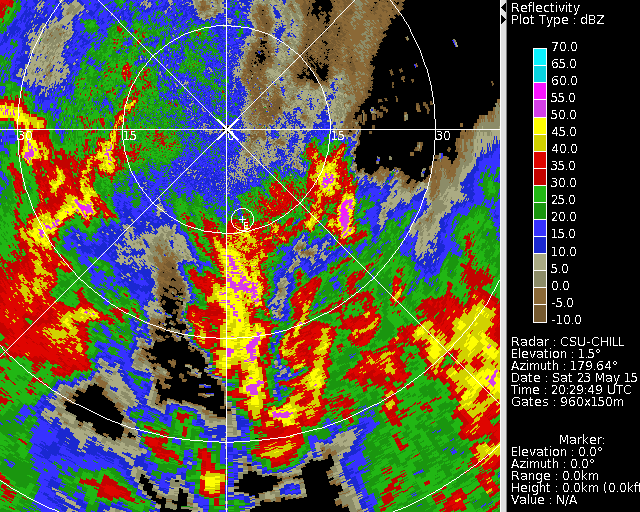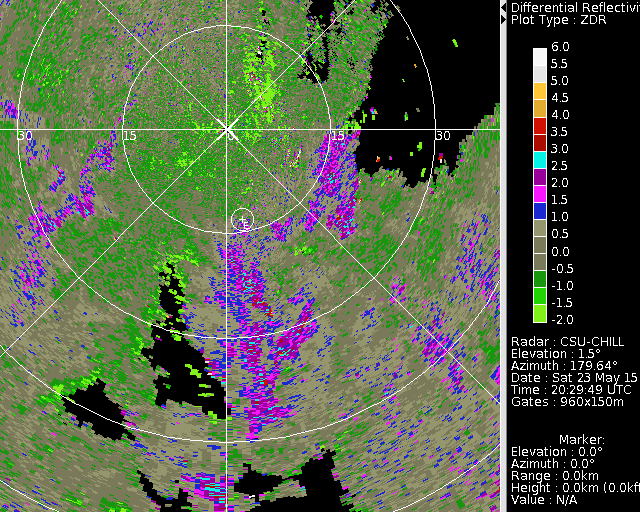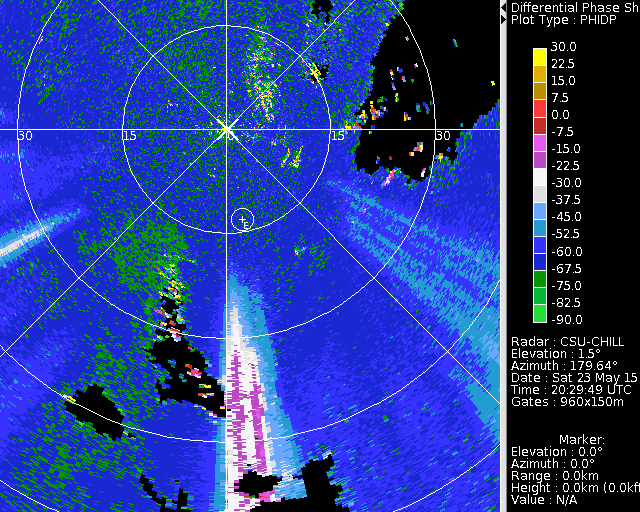DPWX/Modeling observed drop size distributions: 23 May 2015
Authors: Merhala Thurai, Patrick C. Kennedy, and V. N. Bringi
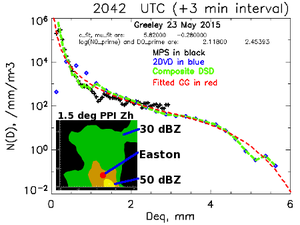
Drop size distribution (DSD) derived from the combined measurements from two optical disdrometers (an MPS and a 2DVD) installed at the Easton Airport (13 km SSE of CSU-CHILL). This rainfall was associated with ~50 dBZ reflectivity at Easton (PPI inset plot). The red dashed line is a generalized gamma distribution fit to the composite DSD data. Three minute DSDs, their fits, and the CSU-CHILL dual-polarization data from various rain rates measured at Easton on 23 May 2015 have been prepared.
Introduction
From April 2015, a six-month rain measurement campaign was initiated at the Easton site 13 km SSE from the CHILL radar site. The campaign involved (i) a 2-D video disdrometer [2DVD, Shönhuber et al., 2008], (ii) a droplet spectrometer called the meteorological particle spectrometer [MPS, Baumgardner et al., 2002], (iii) a Pluvio raingauge [OTT Messtechnik GmbH, 2010], and (iv) a precipitation occurrence sensor system [POSS, Sheppard and Joe, 2008]) all installed within a 2/3rd scaled DFIR double wind fence that was originally installed for the MASCRAD snow observation project (earlier article here.). Many events were recorded by the ground instruments, and for several of these events, a near-complete picture of the rain drop size spectra (from very small to large drops) were derived, by combining the MPS measurements for small drops (< 1 mm) and the 2DVD measurements for larger drops. The shapes of the combined drop size distribution (DSD) spectra had pointed to the need for more flexible model to represent the full DSD [Thurai et al., 2017; Thurai and Bringi, 2017] rather than the standard gamma model. Here we consider a formulation based on the generalized gamma model, previously considered in [Lee et al., 2004 and Raupach and Berne, 2017] for rain DSDs. Specifically, equation (43) in [Lee et al., 2004] is used to derive/fit the four parameters governing this equation, and by setting i=3 and j=4, i.e. using the third and the fourth moments. Here we show a selected case event that occurred on 23 May 2015 which lasted for 90 minutes over Easton, resulting in a total event accumulation of 15 mm. Large drops were recorded by the 2DVD. One example is given below (constructed from the 2DVD front and side view contours, after correcting for any image distortions arising from drop horizontal velocity).
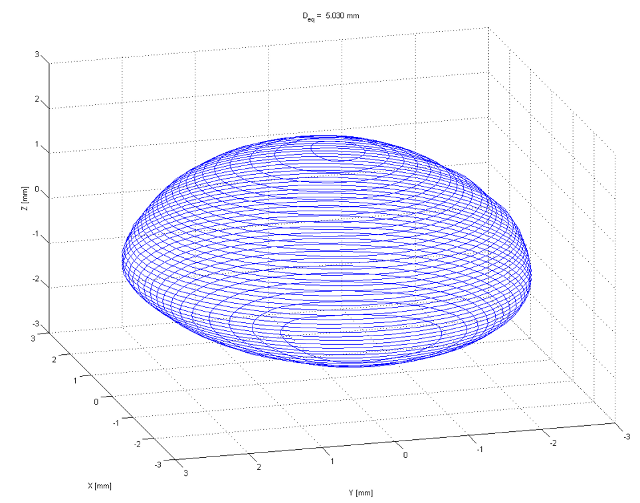
A summary of the DSD measurements from the 2DVD are shown below. Around 20:45 UTC, wide DSD spectra can be seen with drop diameters ranging up to 5 mm and higher.
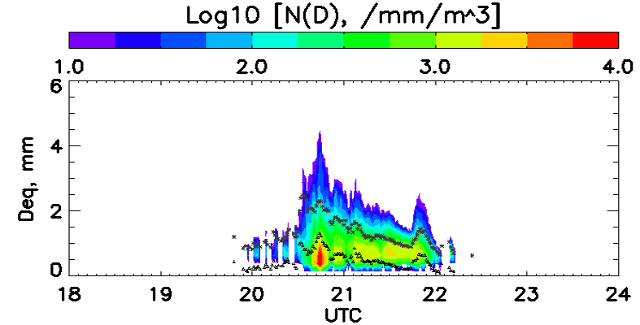
Reflectivity loop
The following loop shows the CSU-CHILL S-band reflectivity data collected in a series of 1.5 degree elevation angle 360 degree surveillance scans that were repeated at ~90 second intervals during the 2028 - 2218 UTC period. This is the lowest elevation angle that is free of ground clutter in the immediate vicinity of the Easton instrumentation site. A wide range of reflectivity values occurred at Easton (marked with a '+ E' sign as various echoes crossed the site in the southerly synoptic flow regime. Maximum reflectivities of ~50 dBZ occurred around the time (2045) when the ~5 mm diameter drop was observed in the first plot shown above.
|
|
||
|
Differential reflectivity loop
The corresponding differential reflectivity (Zdr) values are shown in the next loop. More positive Zdr values, indicative of more oblate drop shapes, generally occurred during the high reflectivity periods. The transitory appearance of negative Zdr values, mainly in the western azimuth sector, is related to rain water draining off of the radome.
|
|
||
|
Differential propagation phase loop
The final image loop shows the evolution of the differential propagation phase field. Increased shifts in differential propagation with increasing range indicate the presence of significant concentrations of oblate drops (i.e., heavy rain). The high oblate drop concentrations in these heavy rain areas retard the propagation of H polarized radar pulses relative to the propagation speed of V polarized pulses along the same beam path. An episode of rapid phidp increases over short range intervals occurred near Easton around 2045 UTC.
|
|
||
|
2045 UTC PPI data
The three figures below show the low elevation sweep that commenced at 2045:07 UTC. Once again, the location of the ground instrumentation site is marked with a ‘+ E’ sign, i.e. at ~ 13 km range along 171.5 deg azimuth. In this region, high Zh values are seen as well as high Zdr values, indicating the presence of large drops at and around this location around this time period. This is consistent with the DSD data shown earlier. The phidp plot shows significant differential phase shifts beyond the ground instrument site, around 45 deg which is high for S band.
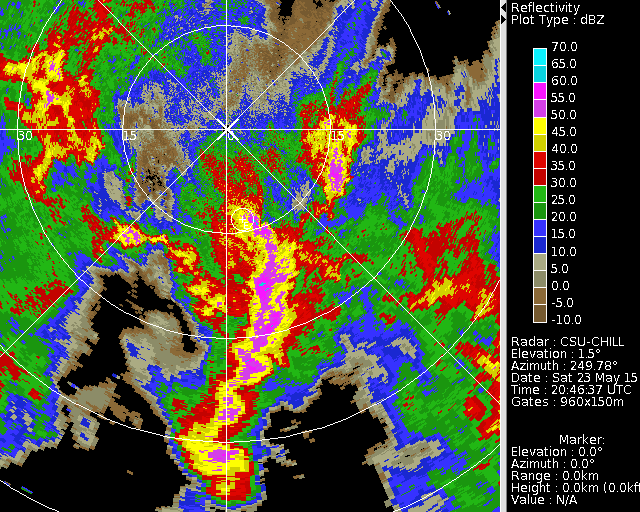
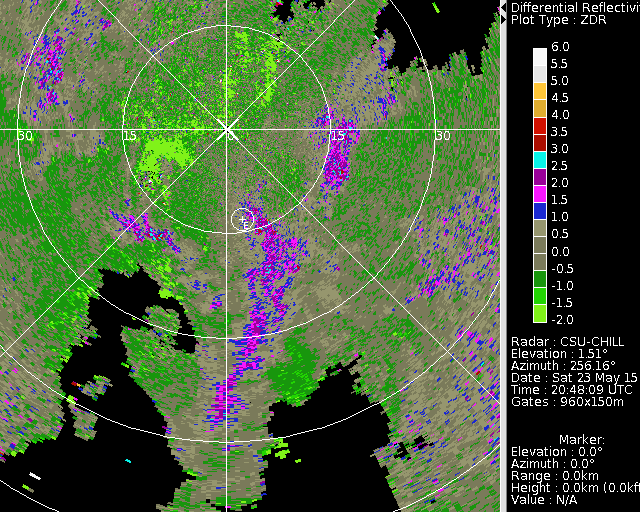
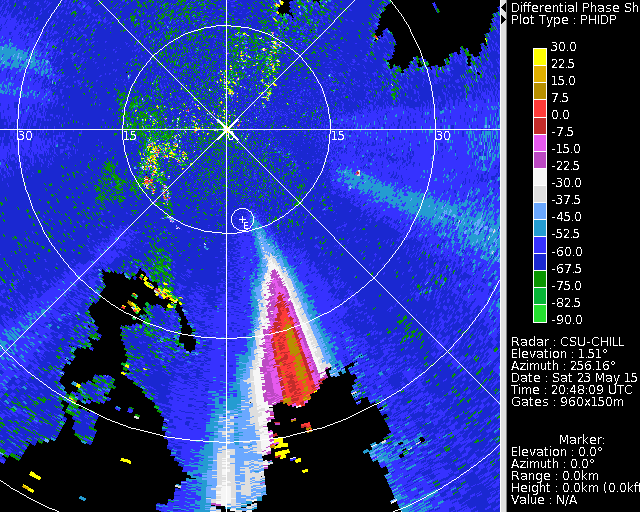
DSD data and fits
The measured DSD spectra (over 3 minutes) which are used as input to the fitting procedure were constructed by utilizing the corresponding MPS-based DSD measurements for 0.15 < Deq ≤ 1 mm and the 2DVD-based DSD measurements for Deq >1 mm. Variation of the data and the fitted curves over the 90-minute period can be seen from the animation below where the MPS data are shown in black, the 2DVD data in blue and the fitted curve in red. In all cases, the fitted curves closely represent the composite DSDs, highlighting the flexibility of the model.
|
|
||
|
As an independent but qualitative verification of the ‘representativeness’ of the fitted curves, the 3 minute rainfall rates were computed from each of the fitted equations and compared with the 3 minute rain rate measurements from the collocated Pluvio. In the figure below the red line represents the estimates based on the fitted model and the purple line shows the Pluvio measurements. Shown below this plot are two examples of 3-minute DSD measurements and their corresponding fits. The left panel shows the plot for the 20:42 – 20:45 UTC period when the rainfall rate reached its maximum value of 60 mm / h, and by contrast the right panel shows the plot for 21:39 – 21:42 UTC period when the rainfall rate was below 5 mm/h. Once again, the flexibility of the fitted model is clearly evident. The model is able to capture the shape of the DSD curves for a wide range of rainfall rates. Note also that in some cases, the shapes of the DSD's resemble equilibrium DSD curves (e. g. McFarquhar, 2004).
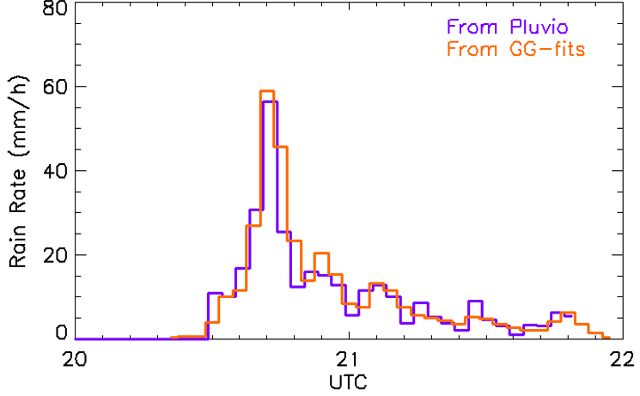
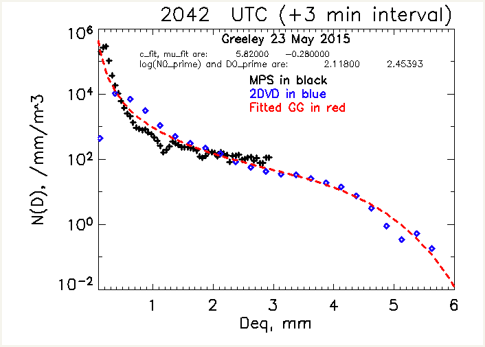
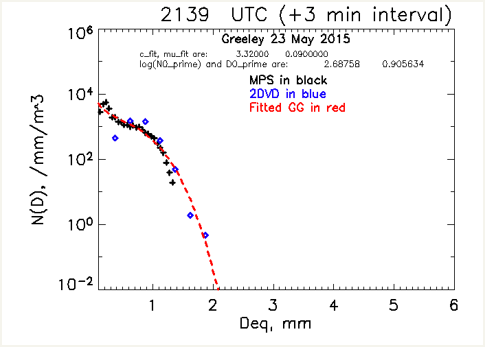
References
Baumgardner, D., G. Kok, W. Dawson, D. O’Connor, and R. Newton, 2002: A new ground-based precipitation spectrometer: The Meteorological Particle Sensor (MPS). 11th Conf. on Cloud Physics, Ogden, UT, Amer. Meteor. Soc., 8.6. [Available online at https://ams.confex.com/ams/11AR11CP/webprogram/Paper41834.html]
Lee, G., I. Zawadzki, W. Szyrmer, D. Sempere-Torres, and R. Uijlenhoet, 2004: ‘A general approach to double-moment normalization of drop size distributions’, J. Appl. Meteor., 43, 264–281.
McFarquhar, G.M., 2004: A new representation of collision-induced breakup of raindrops and its implications for the shapes of raindrop size distributions. J. Atmos. Sci., 61, 777-794.
OTT Messtechnik GmbH, 2010: “Operating instructions Precipitation Gauge OTT Pluvio”.
Raupach, T.H. and A. Berne, 2017: Invariance of the Double-Moment Normalized Raindrop Size Distribution through 3D Spatial Displacement in Stratiform Rain. J. Appl. Meteor. Climatol., 56, 1663–1680.
Sheppard, B. E., and P. Joe, 2008: Performance of the precipitation occurrence sensor system as a precipitation gauge, Journal of Atmospheric and Oceanic Technology, Vol. 25, pp. 196-212.
Shönhuber, M., G. Lammar and W. L. Randeu, 2008: “The 2D-video-vistrometer”, Chapter 1 in “Precipitation: Advances in Measurement, Estimation and Prediction”, Michaelides, Silas. (Ed.), Springer, ISBN: 978-3-540-77654-3.
Thurai, M. P. Gatlin, V. N. Bringi, W. Petersen, P. Kennedy, B. Notaroš, and L. Carey, 2017: Toward Completing the Raindrop Size Spectrum: Case Studies Involving 2D-Video Disdrometer, Droplet Spectrometer, and Polarimetric Radar Measurements, J. Appl. Meteor. Climatol., 56 (4), 877–896.
Thurai M., and V. N. Bringi, 2017: Application of the Generalized Gamma Model to Represent the Full DSD Spectra, Extended Abstract, 38th Conference on Radar Meteorology, 5A.2, Chicago, USA. https://ams.confex.com/ams/38RADAR/meetingapp.cgi/Paper/320599
